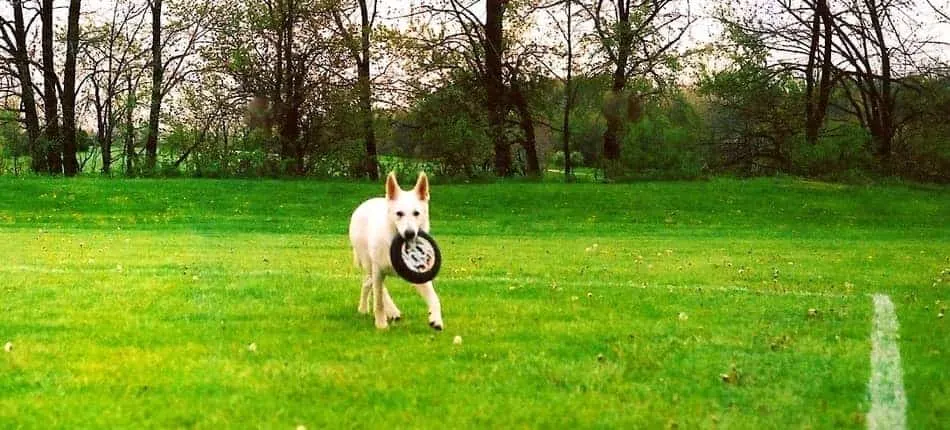
People are sometimes surprised when I tell them that my white German Shepherd is a great frisbee dog.
This is likely because most people typically associate jumping and agility with smaller breeds of dogs.
Because this is a topic that comes up fairly often, I’ve decided to give it some clarity in this post.
So, can German Shepherds play frisbee?
All German Shepherds have the ability to play frisbee. Some of them take to it naturally, while others may need to be taught. But with the proper training, most German Shepherds can be developed into excellent frisbee dogs.
One of my German Shepherds took to playing frisbee quite naturally.
We discovered his love of the game quite by accident as he just lept in the air and intercepted a frisbee intended for a human receiver.
Playing frisbee with your GSD can be a very rewarding activity for both you and your dog.
However, in order to safely play frisbee with your GSD, it’s important that you understand a few points and observe a few basic precautions to make sure that your dog avoids injury.
Click Here to Jump to a Section
Benefits Of Playing Frisbee With Your GSD
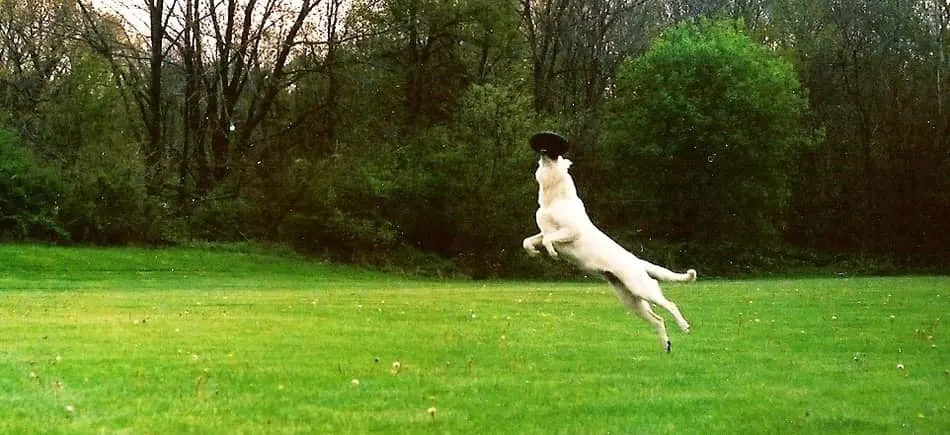
Playing frisbee with your GSD is a useful activity for both your dog and for you. Consider the following points about playing frisbee with your dog:
- It improves communication between you and your dog
- It gives your dog improved coordination
- It improves your dog’s muscle tone
- It sharpens your dog’s reflexes
- It improves your coordination
- It makes your dog more agile
- It improves your dog’s speed
- It sharpens your dog’s vision
- It exercises your upper body
- It gets you outside
- It burns calories
- It’s FUN!
Proper Age To Begin Playing Frisbee
You may find, like I did, quite by accident that your GSD loves to play frisbee. And it’s exciting – for your dog and for you.
Your dog may very well beg you to play as much as possible.
While it may seem like a good idea to begin throwing a frisbee for your dog regularly, be advised that you need to wait until your GSD has physically developed enough to handle it.
At a young age, your GSD is still growing into awareness of its body.
Their thin and lanky bodies tend to move a bit awkwardly, and they are often clumsy.
This is a bad combination for a dog that is hyperfocused on catching a flying object.
Similar to a sports player leaping into the air to catch a ball, your dog will have little regard for the consequences of returning to the ground.
Crash landings will happen at times, and you need to make sure that your GSD has the muscle and bone structure to handle these.
Your GSD’s bones will be almost fully developed by about 12 months.
Therefore, it is advisable to wait until your dog is at least 1 year old before you begin throwing a frisbee to it.
Playing frisbee with your GSD before this age increases the chances of an injury.
Waiting this long gives your GSD the best chance of avoiding it.
So, again, be aware of your GSDs physical limitations, especially while it is a puppy under 1 year old.
Your dog is not concerned about injury, so it is up to you to prevent it.
Frisbee And Hip Dysplasia
Hip dysplasia is defined by the American Kennel Club as:
“a common skeletal condition, more common in large or giant breed dogs…
The hip joint functions as a ball and socket. In dogs with hip dysplasia, the ball and socket do not fit or develop properly, rubbing and grinding instead of sliding smoothly.
This results in deterioration over time and an eventual loss of function of the joint itself.”
Although hip dysplasia occurs in all dog breeds, GSDs tend to be more prone to it due to their large size and active nature.
The condition is hereditary, and GSD dogs have a history of inbreeding their lineage.
Inbreeding has the effect of causing potential birth defects and other genetically inherited health problems (like hip dysplasia).
Because of the higher than average potential of your GSD developing hip dysplasia, it is especially important that you are patient and resist the temptation to begin throwing a frisbee for your GSD at too young of an age (at least 1 year old).
Also, due to the fact that GSDs do have this potiential, make sure that you take your dog to a veterinarian for a check-up before you decide to begin playing frisbee with it.
If there are any potential issues that could be worsened by playing frisbee, your veterinarian will identify these.
Then it is up to you to make an informed decision about whether or not you should move forward with playing frisbee with your GSD.
Safe Frisbee Practices
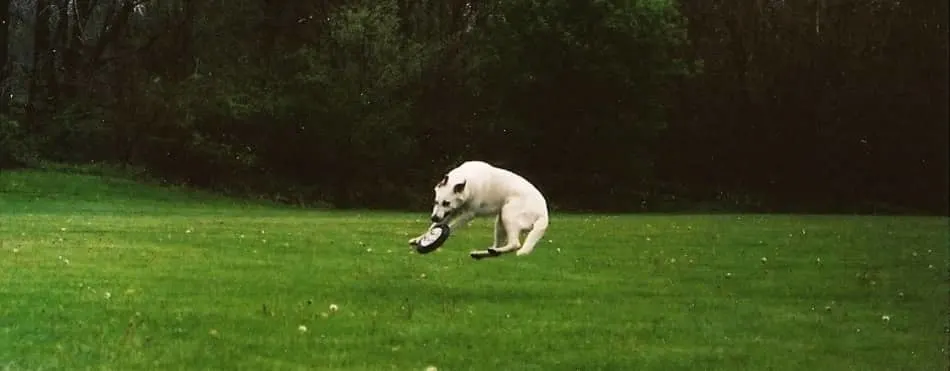
Once you have decided to play frisbee with your GSD, make sure that you are doing your part.
Learn the proper technique to safely throw a frisbee to your dog, and practice until you are confident.
Be careful of how high you throw a frisbee for your dog.
Keeping throws low to the ground does take some practice, so it’s a good idea for you to practice with a two-legged friend before you begin with your GSD.
When your dog is jumping to catch a frisbee, it’s vital that it is landing on all 4 legs at the same time. This distributes the impact of landing.
I can recall times when one of my GSD’s would come down hard on his 2 hind legs (mostly because of a poor throw on my part).
While my dog didn’t seem to notice, I did, and it was painful to watch.
Even though your dog will likely just power through it, and may not even experience any pain because it takes a background to the excitement, you need to stay aware and do what you can to prevent uneven landings.
If your GSD has the habit on its own of landing on its hind legs, you can work with a hoop and teach your dog to jump through it (a regular hula hoop will work just fine).
While jumping through a hoop, your GSD will be forced to pick up its hind legs. This will effectively teach your dog to land evenly on all 4 legs.
Here is a great instructional video that teaches you how to properly throw a frisbee for your dog:
Also, be mindful of the surface on which you are throwing a frisbee for your GSD. If possible, throw it on a beach or on long soft grass.
These surfaces are far more forgiving than solid earth.
A Word Of Caution
Be aware that even if you do take adequate steps to make sure that your GSD stays safe, throwing a frisbee to your dog still carries with it the potential for injury.
They did this because of concern that some dogs may get injured. One of the show’s organizers stated:
“A couple of members of our organising committee, who have experience of larger scale dog shows, suggested there may be risks to dogs that jump high to catch frisbees.”
“We did some due diligence and reluctantly agreed that we should scrap the frisbee category…It is a strange and bizarre decision to make, but one which I suppose we had to make if there is a risk that animals could get hurt.”
“In shows elsewhere, there have been occasions where dogs have jumped high and twisted their back, and there was one where the dog had to be put down.”
“While it can be safe in controlled conditions, if it is thrown at great heights or awkward angles, leading the dog to jump and twist, it can cause strain and injury on landing so care should always be taken.”
Consider that most dogs that compete in frisbee competitions, such as Collies and Australian Shepherds, are smaller and more agile than GSDs, and that even these dogs are at risk for injury while playing frisbee.
This means that you need to be extra cautious when playing frisbee with your GSD.
Do not overlook the fact that this is a strenuous and physically demanding activity for your dog – and don’t put fun before safety.
Frisbee And Your Dog’s Teeth And Gums
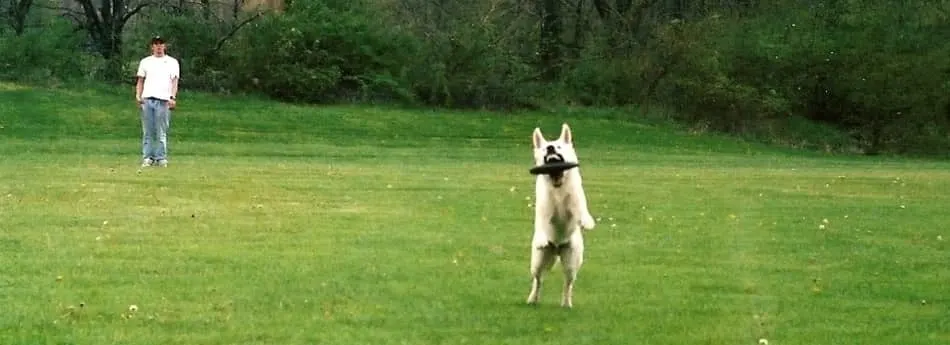
Repeatedly catching a frisbee, over time, can have a negative effect on your GSD’s teeth and gums.
Teeth wear down and gums bleed.
Although there are a number of frisbees designed to prevent this by being constructed out of cloth or vinyl, many GSDs, including my own, rather dislike playing with these as an alternative to the real thing.
To avoid this, simply don’t expose your GSD to a standard frisbee in the first place. Start out with a specifically designed dog frisbee (or disk).
Soft Frisbees (Disks)
Using a soft frisbee specifically designed for dogs is a good idea, but you should also be aware of the potential negative effects they can have on your dog’s dental health.
While soft frisbees themselves may not be damaging to your GSD’s teeth and gums, the grit and small stones attached to them can.
When your dog catches a frisbee over and over, the frisbee will become covered in its saliva.
And every time it touches the ground, especially on sand, there will be some grit which attaches to the frisbee.
This grit then rubs against your dog’s teeth and gums repeatedly.
A little bit here and there will not have a serious impact, but over time the effect can be much like that of sandpaper on wood.
Some soft frisbee manufacturers claim that their product gets in between your dog’s teeth and removes plaque and tartar.
While this may be true, the grit which becomes embedded in cloth frisbees can also remove the enamel covering your dog’s teeth.
So what can you do?
- Limit the amount of time you spend throwing a frisbee to your dog. An extra 5 minutes here and there will add up quickly. So be conscious of the time during each frisbee session.
- Take the time to dust off the frisbee before each throw. Doing this before every throw adds up the same way as not doing it. A few moments of your time in the long run will help to protect your GSD’s teeth and gums.
- Give your dog frequent water breaks. This will not only keep your dog hydrated, but it helps to rinse any debris from its mouth.
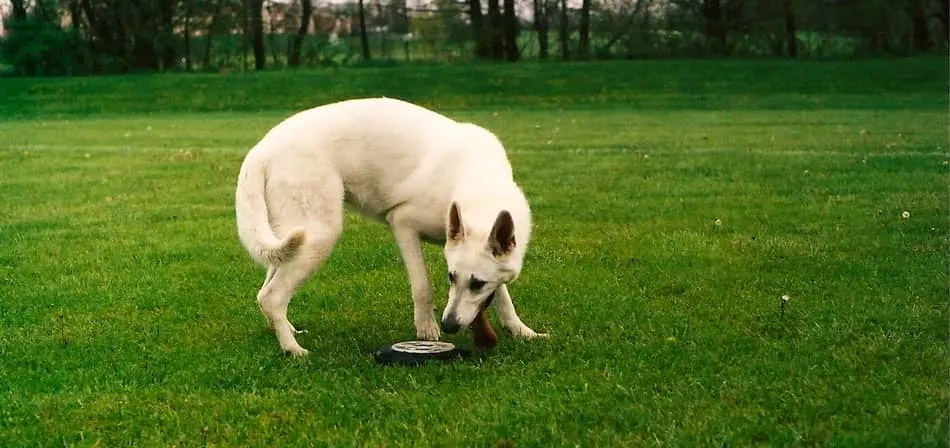
Final Thoughts
Remember that while playing frisbee with your GSD can be great exercise and a lot of fun, you do need to exercise the precautions listed above.
Doing so will ensure that it’s an activity that you and your dog can do together for years to come.
